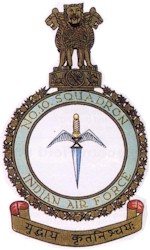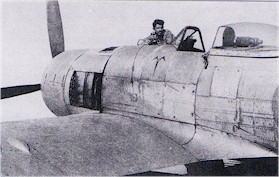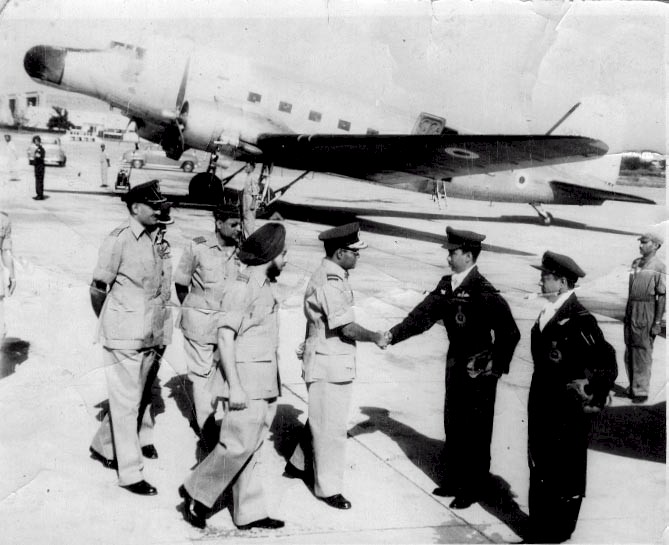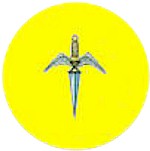
“Winged Daggers”
Yudhyay Krutanischay – Into War with Determination
Birth and the Second World War.
The last Indian Air Force Squadron to be raised during the Second World War was No.10, the ‘Winged Daggers’. The Squadron was formed on 20th February 44 at Lahore and was equipped with the Hawker Hurricane IIc fighter. The unit was not a pure IAF one, but more a ‘commonwealth’ formation with a fair bit of British pilots as well as Australian and New Zealanders thrown in. The first Commanding officer of the unit was Sqn Ldr RFT ‘Bob’ Doe DFC and Bar. Doe was a distinguished ace who flew with the Fighter command during the Battle of Britain and had a tally of more than 15 Luftwaffe bombers and fighters to his credit.
The Squadron commenced training shortly thereafter and had moved between locations at Lahore, Risalpur, carrying out Armament training at Amarda road, Ranchi, Salbani etc. At the beginning of November 1944, the Squadron’s was designated as a Hurribomber unit with primary focus on Air to Ground support. Accordingly the unit started its bombing practice sorties at Ranchi. The first fatality of the unit occurred on 15th Nov 44 , when Fg Off BB Chakerberty failed to recover from a dive in his Hurricane and crashed. It was believed to have been to a high speed stall.
The first taste of operations was began on 23 Dec 44, when No.10 flew into Ramu and commenced operations. They participated in the Kaladan Valley campaign, attacking Japanese ground forces, and providing continuos support to the 81st West African division. On occasions the squadron also provided escort to B-24 Liberators and acted as pathfinders on other sorties. The Squadron provided fire bomb support to the Taungup river area , escorted by Spitfires of No. 273 RAF Squadron.
Several Indian pilots got their grounding in the squadron around this time. Ranjan Dutt, MM Crishna, Suri were some of the Indians who were involved in the operations. Flt Lt EDSN ‘Eddie’ Sparkes , an RAF Pilot deputed to the Squadron has several interesting anecdotes and details of operations described on his website here. For his leadership and role in the Campaign, the CO, Sqn Ldr Doe was awarded the Distinguished Service Order (DSO) in October 45. The unit remained on the frontline and participated in operations till the end of April 1945 when it moved to Yelahanka for requipping with Spitfires. The Spitfires arrived in Mid July and No.10 was fully ops on the Spitfire by September 45 when it was moved to the Burma front again under Sqn Ldr RW Jones.
The Squadron became ‘all-Indian’ on 5 Jan 46 with the posting out of the last Non-Indian officer and Sqn Ldr H Raza taking over as the CO. The unit remained in Burma till Feb 46. One of the tasks during this time was to provide escort to the Supreme Allied Commander of the theatre, Lord Louis Mountbatten on his flight to Bangkok. The unit also provided a flypast to the King of Siam during the tenure.
Sqn Ldr H Moolgavkar took over command in May 47 when the Squadron was based at Chakeri. Soon afterwards on Independence, the unit provided the first formation flypast over the National Stadium in Delhi where Pandit Nehru was inspecting the combined armed forces parade on Independence day. The next day the squadron participated in the flypast over the Redfort.
1947-48 Kashmir Operations
The unit was under command of Sqn Ldr Zafar Shah when it was called upon to provide support to ground troops in the first ever operations after Independence in November 47. Several Tempest fighters were moved to Ambala from where they carried out operations over the Srinagar Valley and later on in other areas. Operating from Ambala and Amritsar and later from Srinagar and Jammu as Advanced Landing grounds, the aircraft of the Squadron carried out more than 300 sorties in support of JAK Force. More than 20000lbs of bombs , 500 Rockets and 20000 rounds of 20mm cannon were dispensed at enemy targets. Not only were enemy troops bombed and strafed, enemy 25 pounder artillery gun positions were rocketed and offensive recce sorties flown.
Sqn Ldr Zafar Shah was awarded the Vir Chakra for his leadership of the Squadron during the operations. Flt Lt D Subia also received the Vir Chakra for the operational missions flown during the war, as did others.
|
|
 |
| The Winged Dagger emblem of No.10 Squadron was officially approved by the President of India in December 1955. The emblem was in use unofficially since the late 1940s, as can be seen on the photograph on the right.
The specially fashioned Dagger, which received formal approval on 26 May 83, symbolises the lethality of their splendid weapon. Squadron motto “Yudhyay Krutnischay”. The combination of cross guard and Quillon is designed to include the squadron number (in Roman character) along with its operational intent of mobility in third dimension. |
|
1949-64 : Peace time responsibilities.
At the end of hostilities , the unit moved to Palam to settle down for the rigours of peace time flying. Whenever tensions flared up, the unit would send detachments to forward airbases. The squadron was to fly the Tempest for six long years till Dec 53 when it handed over its Tempest IIs to requip with the De Havilland Vampire FB.52 . Less than two years elapsed, when the Squadron was allocated Vampire NF.54s and given a night fighting role. The nightfighter Vampires arrived in 1954, and the squadron was permanently stationed at Palam to provide Night defence to the Capital under the CO Sqn Ldr David Bouche. The first aircrew received training at UK, but subsequent crews and navigators got their training within the squadron with the help of T.55 trainer variants.
The Vampire NF.54s were two seater aircraft like the Vampire T.55 trainer that allowed a radar operated to be seated in the widened cockpit. However unlike the T.55, the aircraft did not give the luxury of escape by ejection seat to the aircrew in the event of an emergency. Thanks to its tremendous maintenance and safety record of the Squadron, the unit lost only one aircraft and crew during its tenure flying the night fighter Vampires. All the night flying led the unit to get a nickname ‘Black Knights’ over the years. Combined with their privileged task of protecting the capital , the Squadron considered themselves the elite. They were the only unit to wear Black flying overalls to this effect.
A Unique feature of the squadron was that it was the only fighter squadron to have a Dakota on its establishment. The squadron had a C-47 (HJ-849) which was equipped in the nose with a airborne radar in a special radome. The aircraft was used to train the Navigators in blind interception techniques and presented a unique sight in the squadron. Nicknamed as the ‘Nosey Dakota’ or ‘Cleopatra’, a transport pilot was usually allocated to the squadron to fly it. Providing the few occasions where transport pilots were actually part of a fighter unit!

‘Nosey’ Dakota HJ- 849 seen in the background as the AOC-in-C WAC, AVM Erlic Pinto inspects the staff of the Squadron. The CO, Sqn Ldr BS Sikand is to his rear
The Squadron was put up on alert during the 1961 Goa operations and the Indo China War of 1962. Morale of the pilots was high, but the aircraft were starting to show fatigue related problems. Serviceability was quite low towards the end of 1963 and finally Air HQ numberplated the squadron in April 1964 and No.10 went into hibernation for three long years.
1967 Return of the Elite:
The Squadron was re-raised again at Jamnagar in April 67 under Wg Cdr V Krishnamurthy. The unit was given the privilege of being the first to be equipped with India’s first indigenously designed and built supersonic aircraft, the HAL HF-24 Marut. The Marut had been in development for quite some time and the Aircraft and Armament Testing Unit had already been carrying out trials at Jamnagar. No.10 Squadron now had the unique responsibility of sharing the work load and putting the new aircraft through its paces. The pilots practiced Air to ground gunnery, Combat Air Patrols, dog fighting etc. During one of the training sorties in Jul 67, Wg Cdr Murthy was unable to locate Jamnagar and ran out of fuel. The aircraft was lost after his ejection.
Wg Cdr Gaboo Sen took over in September 67 and the squadron moved to Pune in earnest. Wg Cdr ON ‘Piloo’ Kacker took over command in April 70 when Sen was posted to Air HQ and it was under his command the unit moved to Jodhpur and then to Uttarlai in the latter half of 1970. Tragedy stuck on 1st September, when ‘Piloo’s aircraft had a tyre burst on take off and engine flame out due to the ingestion of rubber from the tyres. The aircraft lost power and crashed just outside the Uttarlai airfield killing the CO. It was about a month and a half before the new CO Wg Cdr KC Aggarwal took over command. It was under his leadership the Daggers went into action in the 1971 War.
Operations in the 1971 War:
When war broke out on 3rd December 71, The Daggers were sharing the Uttarlai airbase with another HF-24 Unit, No.220 Squadron ‘ Desert Tigers’. On the first day, the Pakistanis attacked Uttarlai using a sole B-57 bomber which was ineffective. The next day, on December 4th, No.10 flew its first mission of the war to Hyderabad Sind. The Maruts made short work of the airfield installations. No aircraft were observed. Targets at Naya Chor and trains at Dhoro Naro were also attacked as a part of the day’s missions.
The missions continued the next day which included Umerkot. One mission returning to Uttarlai observed some Sabres doing ground attack and promptly engaged them. The Sabres however refused combat and disengaged. On the 9th, Wg Cdr Aggarwal led a very effective raid on the Mirpur Khas Railway yards, where several trains and locomotives were destroyed. The squadron suffered their first casuality when Sqn Ldr AV Kamat was shot down by AA fire over the Hyderabad Sind airfield. Kamu ejected to be taken POW. Two Maruts of the Squadron returning from a dusk mission were bounced by two F-86s, but they managed to shake off the attackers by hitting deck level and pouring on the gas. No aircraft, Sabre or Hunter, can catch the Marut in level flight at full speed.
The sorties were repeated on the 10th December, the aircraft using 1000 lb bombs and 68 mm rockets to attack the railway yards. On the 11th of December, two Maruts were taking off from Uttarlai when two F-104 Starfighters made a sudden appearance and strafed the aircraft. Sqn Ldr MS Jatar VrC, the pilot of one of the Maruts, extricated himself from one of the burning aircraft. Flt Lt Sidhu managed to swerve his Marut off the runway into a sand bank and escape damage. Jatar’s Marut was lost, and he suffered some severe burn injuries.
The subsequent days, the No.10 made its presence felt attacking targets in the Sind region. On occasions the Maruts received escorts from the MiG-21 FLs of No.29 Squadron which had based a detachment at Uttarlai. On Dec 17th, the last day of the war, A Marut formation of the Squadron being escorted by two MiGs was attacked by two F-104s. The escorting Migs managed to shoot down both the Starfighters. This was the last sortie for the Squadron.
For the tremendous effort put up by the Squadron, the CO Wg Cdr Aggarwal was awarded the Vir Chakra, as was Flt Lt WR Sanjeeva Rao, who was an FAC in a forward area. In addition to these, one VM was awarded to Sqn Ldr AV Kamat and two Mentioned in Dispatches were awarded to the personnel of the Squadron.
After the war, No.10 moved to Jodhpur and continued there for sometime. The Daggers won many accolades later on, including the ‘Best Marut Squadron’ in 1977 and ‘Best Fighter Squadron’ in 1978. The accident record of the squadron was zero throughout this period. The squadron was earmarked for conversion to the MiG-23BN in 1980, the last CO of No.10 whilst flying the Marut being Wg Cdr DS Jatar. The squadron handed over its Maruts to other units in August 1980 and many of its pilots were posted out or sent for training to Russia.
Coming of the Floggers
The unit was reraised on 1st January 1981 equipped with the MiG-23 BN ground attack aircraft. Wg Cdr RL Bamzai having the honor of being the first MiG-23BN CO of the unit. The Squadron received its MiGs on 20th of Jan and immediately displayed them for the republic day flypast in Delhi six days later. The unit received a complement of MiG-23UM two seaters for type training.
18 March 1985 was a red letter day for the squadron. It received the president’s colors from the then president Shri Gyani Zail Singh in a splendid ceremony at Jodhpur. The ceremony was combined with the presentation of colors to No.11 Squadron flying the HS-748.
The unit underwent normal training and operational exercises throughout the 80s. Wg Cdr Jimmy Bhatia VrC and Bar led the Squadron in 1985. The aircraft of the squadron also participated in the various photo oppurtunies for IAF calendars and photo shoots.
In 1993, the Flogger Ds of the Squadron gave way to the Flogger Js. Better known as the MiG-27M Bahadur, It was a more stable and armoured version of the MiG-23 BN and in many ways was called the ‘Flying tank’. The CO Wg Cdr Kocher led a team of four pilots to ferry the first four aircraft from HAL Ozhar to Jodhpur on 1st November 1993. The remaining aircraft came by the end of the month. The Squadron was fully ops on the MiG-27 by the fiftieth anniversary of its raising in February 1994. Today the Squadron operates the Upgraded MiG-27s from Jodhpur – one of the only two units to be equipped with the type.
The IAF’s tenth senior most squadron completed fifty years and in this period fought in a world war, and two of India’s four major conflicts. Few units can boast of such a record and honour!
TABLES
List of Commanding Officers of No.10 Squadron
Gallantry and Service Awardees of No.10 Squadron
Aircraft Types operated by No.10 Squadron
| Aircraft Type | From | To |
| Hawker Hurricane IIc | Feb 44 | Apr 45 |
| Supermarine Spitfire VIII | July 45 | May 47 |
| Hawker Tempest II | May 47 | Dec 53 |
| De Havilland FB52 Vampire | Dec 53 | Aug 53 |
| De Havilland NF54 Vampire | Aug 53 | Apr 64 |
| HAL HF-24 Marut | Apr 67 | Aug 80 |
| Mikoyan Gurevich MiG-23BN Vijay | Jan 81 | Dec 93 |
| Mikoyan Gurevich MiG-27M Bahadur | Dec 93 | Till Date |
| Other Types operated by the Squadron as trainer and hack aircraft: Harvard IIb, Douglas Dakota C-47, Vampire T.55 , Hunter T.66, HF-24 Marut 1T, MiG-23UB | ||
Locations of the Squadron
| Locations Post 1947 | From | To |
| Chakeri – Kanpur | 1947 | 1947 |
| Ambala | 1947 | 1947 |
| Srinagar | 1947 | 1948 |
| Palam | 1948 | 1951 |
| Barrackpore | 1951 | 1951 |
| Halwara | 1951 | 1952 |
| Palam | 1952 | 1964 |
| Jamnagar | 1967 | 1969 |
| Poona | 1969 | 1970 |
| Jodhpur | 1971 | 1971 |
| Uttarlai | 1971 | 1971 |
| Jodhpur | 1971 | Till Date |
Acknowledgements:
Special Thanks to Mr. Pushpindar Singh for his article on 10 Squadron which has formed the basis for this history.
References:
No.10 Squadron, The Winged Daggers by Mr. Pushpindar Singh, Wings of Fame, Volume 12
History of the Indian Air Force 1933-1945 by Mr. SC Gupta, Combined Historical Cell, India-Pakistan Armed Forces.
My years with the Indian Air Force by Air Chief Marshal PC Lal, Lancer Publications
The mumblings of Eddie Sparkes by Flt Lt EDSN Sparkes, http://users.zetnet.co.uk/sparkes
No.10 Squadron History, Official Indian Air Force Site at http://www.indianairforce.nic.in/airforce/10sqn.htm
